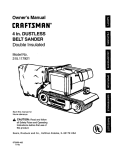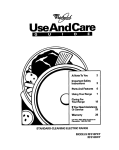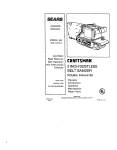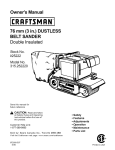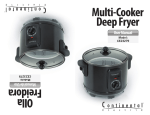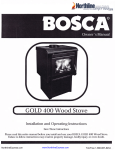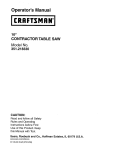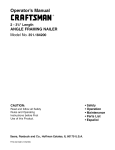Download Craftsman 315.117120 Owner`s manual
Transcript
OWNER'S MANUAL MODEL NO. 315.117120 CAUTION: Read Rules for Safe Operation and All Instructions Carefully CRAI:TSMAK 3 Inch Belt Sander Double Insulated Warranty Introduction Operation Maintenance ® Repair Parts Designed exclusively for an_pl<t e_L _ SEARS, ROEBUCK AND CO., Hoffman Esfate_,]L 612547-768 11-C0 6_9 FULL ONE YEAR WARRANTY ON CRAFTSMAN BELT SANDER Ifthis Craftsman Belt Sander fails to_gr ive complete sattsfaction within one_yl ear from the date of purchase, RETURN IT TO THE NEAREST SEARS STORE IN THE UNITED STATES, and _ears will repair it, free of charge. Ifthis Craftsman Belt Sander is used for commercial or rental purposes, this warranty applies for only 90 days from the date of purchase. This warranty gives you specific legal rights, and you may also have other rights which vary from state to state. Sears, Roebuck and Co., DEPT. 817 WA, Hoffman Estates, IL 60179 INTRODUCTION DOUBLE INSULATION is a concept in safety, in electric power tools, which eliminates the need for the usual three wire grounded power cord and grounded supply system. Wherever there is electric current in the tool there are two complete sets of insulation to protect the user. All expOSed metal parts are isolated from iotemal metal motor components with protecting insulation. IMPORTANT - Servicing of a tool with double insulation requires extreme care and knowledge of the system and should be performed only by a qualified service technician, For service we suggest you return the tool to your nearest Sears Store for repair. Always use original factory replacement parts when servicing. GENERAL Your Craftsman Belt Bender is suitable for coarse, medium and fine sanding of wood, metals, plastics and other materials. It is ideal when used for smoothing rough boards, chamfering, rounding edges and many other general Sanding applications. it is also an excellent tool for removing paint, varnishes, and stains, its balanced design makes it easy to use. RULES FOR SAFE OPERATION READ ALL INSTRUCTIONS 1. 2. 3, 4. 5. 6. KNOW manual tations related GUARD YOUR POWER TOOL - Read owner's carefully. Learn its applications and limias well as the specific potential hazards to this tool. AGAINST ELECTRICAL SHOCK BY PREVENTING BODY CONTACT WITH GROUNDED SURFACES. For example: Pipes, radiators, ranges, refrigerator enclosures. KEEP GUARDS IN PLACE and in working order. KEEP WORK AREA CLEAN. Cluttered areas and benches invite accidents. AVOID DANGEROUS ENVIRONMENT, Don't use power tool in damp or wet locations or expose to rain. Keep work area well lit. KEEP CHILDREN AND VISITORS AWAY. All visitors should wear safety glasses and be kept a safe distance from work area. DO not let visitors contact tool or extension cord. 7. STORE IDLE TOOLS. When not in use tools should be stored in a dry, high or focked-up - out of the reach of children. place 8. DON'T FORCE TOOL. It will do the job better and safer at the rate for which it was designed. 9. USE RIGHT TOOL. Don't force small tool or at- tachment to do the job of a heavy duty tool. Don't use tool for purpose not intended - for example Don't use a circular saw for cutting tree limbs or logs. 10. WEAR PROPER APPAREL. No loose clothing or jewelry to get caught in moving parts. Rubber gloves and non-skid footwear are recommended when working outdoors, Also, wear protective hair covering to contain long hair and keep it from being drawn into air vents. Page 2 RULES FOR SAFE OPERATION (Continued) 11. ALWAYS 12, 13. 14, 15. 16, WEAR SAFETY GLASSES. Everyday eyeglasses have only impact-resistant lenses; they are NOT safety glasses. PROTECT YOUR LUNGS. Wear a face or dust mask if operation is dusty, PROTECT YOUR HEARING. Wear hearing protection during extended periods of operation. DON'T ABUSE CORD. Never carry tool by cord or yank it to disconnect from receptacle. Keep cord from heat, oil and sharp edges. SECURE WORK, Use clamps or a vise to hold work, Both hands are needed to operate the tool. DON'T OVERREACH, Keep proper footing and balance at all times. DO not use on a ladder or unstable support. 17. MAINTAIN TOOLS WITH CARE. Keep tools sharp at all times, and clean for best and safest performance. Follow instructions for lubricating and changing accessories. 18. DISCONNECT TOOLS. When not in use, before servicing, or when changing sanding belts, attachments, blades, bits, cutters, etc., all tools should be disconnected from power supply. 19. REMOVE ADJUSTING KEYS AND WRENCHES. Form habit of checking to see that keys and adjusting wrenches are removed from tool before turning it on, 20. AVOID ACCIDENTAL STARTING, Don't carry rlugged-in tools with finger on switch, Be sure switch is off when plugging in, 21, MAKE SURE YOUR EXTENSION CORD IS IN GOOD CONDITION. When using an extension cord, be sure to use one heavy enough to carry the current your product will draw, An undersized cord will cause a drop in line voltage resulting in loss of power and overheating, A wire gage size (A,W.G,) of at least 16 is recommended for an extension cord to0 feet or less in length. A cord exceeding 100 feet is not recommended, if in doubt, use the next heavier gage. The smaller the gage number, the heavier the cord, 22, OUTDOOR USE EXTENSION CORDS. When toot is used outdoors, use only extension cords suitable for use outdoors. Outdoor approved cords are marked with the suffix W-A, for example SJTW*A or SJOW-A. 23. NEVER USE THIS OR ANY POWER SANDER FOR WET SANDING, Failure to comply can result in electrical shock causing serious injury or worse, 24. KEEP HANDS AWAY FROM SANDING AREA. 25. NEVER USE IN AN EXPLOSIVE ATMOSPHERE. 26. INSPECT 27. damaged, have repaired at your nearest Sears Repair Center, Stay constantly aware of cord location. INSPECT EXTENSION CORDS PERIODICALLY TOOL CORDS PERIODICALLY aed if and replace if damaged. KEEP HANDLES DRY, CLEAN, AND FREE FROM OIL AND GREASE. Always use a clean ctoth when cleaning. Never use brake fluids, gasoline, petroleum-based products or any strong solvents to clean your tool, 29. STAY ALERT. Watch what you are doing and use common sense. Do not operate tool when you are tired. Do not rush. 30, CHECK DAMAGED PARTS. Before further use of the tool, a guard or other part that is damaged should be carefully checked to determine that it wnl operate properly and perform its intended function. Check for alignment of moving parts, binding of moving parts, breakage of parts, mounting, and any other conditions that may affect its operation. A guard or other part that is damaged should be properly repaired or replaced by an authorized service center unless indicated elsewhere in this instruction manual, 31, DO NOT USE TOOL IF SWITCH DOES NOT TURN IT ON AND OFF, Have defective switches 28, replaced by an authorized service center. Inspect for and remove all nails from lumber before sanding. 33. DRUGS, ALCOHOL, MEDICATION. Do not operate tool while under the influence of drugs, alcohol, or any medication. 34, DO NOT USE THIS SANDER FOR OVERHEAD SANDING. Overhead sanding coold result in dropping sander or loss of control, These situations could result in an accident resulting in possible serious injuPJ. 35. WHEN SERVICING USE ONLY IDENTICAL CRAFTSMAN REPLACEMENT PARTS. 36, POLARIZED PLUGS. To reduce the risk of electric shock, this tool has a polarized plug (one blade is wider than the other). This plug will fit in a polarized outlet only one way. If the plug does not fit fully in the outlet, reverse the plug. If it still does not fit, contact a qualified electrician to install the proper outlet. Do not change the plug in any way. 37. SAVE THESE INSTRUCTIONS. Refer to them 32, Normal sparking of the motor could ignite fumes. Page 3 frequently and use to instruct others who may use this tool. tf you loan someone this tool. loan them these instructions also. OPERATION KNOW YOUR BELT SANDER Before attempting to use your sander, familiarize yourself with all operating features and safety requirements. See Figure I. Make sure power supply is 120 volts, 60 I_t, AC only (nOrmal household current). TRACKING SCREW--_ "LOCK'ON" BuI"rON REAR HANDLE SWITCH TRIGGER HANDLE DRIVE ROLLER ASSEMBLY PLATEN ASSEMBLY (INCLUDES YOKE ASSEMBLY) *SANDING BELT FRONT PULU = Page Fig. I 4 OPERATION SWITCH The switch of your sander is equipped with a "lock-on" feature which is convenient when sanding for extended periods of time. To lock-on, simply depress the switch trigger, push in the lock button located on the side of the handle, then while holding the lock button pushed in, release the switch tdgger. See Figure 2. To release the lock, depress the tdgger and release it. BE SURE TOOL IS NOT IN THE "LOOK-OR" POSITION BEFORE CONNECTING TO POWER SUPPLY SOURCE. DO Nor LOCK THE SWITCH TRIGGER ON JOBS WHERE YOUR SANDER MAY NEED TO BE STOPPED SUDDENLY. PREPARING Fig. 2 FOR OPERATION Forease of operationyour sander has a fronthandic and a rear handle. These handles allow two-hand operation which aid in maiofainicgcontrol,keepingsanding area level withworkpiece, and keepinghands clear of sanding pelt. When operating your sanderalways holdthe fronthandle with your left hand and the rear handle with your right hand as shown in Figure 3. CORRECT Fig. 3 Always operate your sander as shown in Figure 3. Selecting the correct size gdt and type sanding belt is an extremely important step in achieving a high quality sanded finish. Standard 3 in. x 21 in. sanding pelts made of aluminum oxide, silicon carbide, and other synthetic abrasives are best for power sanding. Natural abrasives, suchas flintand garnet are too soft for economical use in power sanding. In general, coarse gdt sanding halts will remove the most matedal and finer grit sanding belts will produce the best finish in all sanding operations. The condition of the surface to be sanded will determine which gritwill do the job. If the surface is rough, start with a coarse grit and sand until the surface is uniform. Medium gdt may then be used to remove scratches left by the coarser grit and finer gtit used for finishing of the surface. Always continue sanding with each grit until sudace is uniform. Page 5 KEEP HANDS AND FINGERS AWAY FROM THESE AREAS AT ALL TIMES Fig. 4 OPERATION INSTALLING/REMOVING 1. SANDING BELT UNPLUG YOUR SANDER. Tension must be released on the front pulley in order to install and remove sanding belt. To release tension on the front pulley, you must depress the front pulley untilthe notch in the platen assembly wilt fit the slot, then rotate the notch onto the slot. See Figure 5. To release 2. tension on front pulley: NOTCH Place the front pulley ofyour sander against the corner of a workbench as shown in figure 6. NOTE: The left side of your sander should be positioned as shown so that the motor housing will not come in contact with workbench when front puitey is compressed. 3. Hold your sander firmly with both hands and push the frent pulley against the comer ofworkbench as shown in figure 6. 4. Once the front pulley has been compressed enough to allowtbe notch in the platen assernbly tofitthe sloton the platen assembly, rotate your sander in the direction of the arrows shown in figure 6. 5. When propedy compressed, tbe front pulley wilt rernain in a retracted position as shown in figure 7. This allows new sanding belt to be instaited, and frees old sanding ban so it can be removed. To install 6. sanding FRONT SLOT PULLEY TO RELEASETENSION: COMPRESS FRONT PULLEY AND ROTATE NOTCH iNTO SLOT Fig. 5 / \ belt: Install new sanding belt making sure arrow inside of belt is pointing in the direction of sander rotation. Sander rotation is clockwise when looking into open side of sander. See Figure 8. NOTE: The arrow inside sanding belt indicates the bait's direction of rotation, while the direction of rotation of the drive roller indicates the sanders direction of rotation. Fig. 6 Sanding belts installed backwards can create a hazardous condition. 7. Roughly align sanding belt to its correct position, then apply tension to front pulley. When correctly adjusted, the outer edge of the sanding belt will be even with the outer edge of the platen assembly. 8. Apply tension to ftont pulley by pressing or tapping itwith e blockof wood in the direction of the anew as shown in Figure9. The pulley willsnap beck into operatingposition, FRONT PULLEY IN RETRACTED SHOWN PosnloN Fig. 7 Page 6 OPERATION TO ADJUST SANDING BELT TRACKING See Figure 10. TO adjust sanding belt tracking, connect sander to power supply. Hold sander as shown in figure 1O. pultswitchtdgger and release immediately. NOTE: This position is for adjustments only. Sanding belt should not be in contact with workpiece or any foreign objects when making belt tracking adjustments, Observe tracking of sanding belt, If the sanding belt rur_s inward,slOWlyturnthe trackingscrew clockwise. Itthe sanding belt runsoutward, slowly turnthe tracking screw counterclockwise,This should be done untilyouare sure belt willnot runoff sander, or come in contact withintemal pads, After inslallinga new sanding belt, it may become necessary to change the adjustmentseveral times untilthe belt becomes pUable. SANDING BELT Fig. 8 When you are sure the beltwill not rubagainst internal pads, start your sander and fine adjust the tracking screw untilthe belt stabilizes. See Figure 10. When correctly adjusted, the outer edge of the bch will be even with the outer edge of the platen assembly. Belt lifewill be greatly increased ifa few seconds are spent adjustingthe belt tracking, TO PLACE TENSION ON SANDING BELT, PRESS OR TAP FRONT PULLEY Fig. 9 TO ADJUST SANDING BELT TRACKING: TURN TRACKING SCREW AS SHOWN Fig. 10 REPLACE TORN SANDING BELTS IMMEDIATELY. NOTE: The front pulley of your sander was not designed for contour sanding. Sanding on the front pulley could cause irregularity in sanding belt tracking. Page 7 OPERATION TO OPERATE Clamp or otherwise secure the work to prevent it from moving under your sander. Before placing sander on work surface, squeeze the switch trigger and let the motor reach its maximum speed, then lower your sander to the work surface with a slight forward motion,Using the rear handle to control your sander and the front handle only to guide it, move itslowly over the work. See Figure 1I, Allowing your sander to remain in one place will result in an uneven surface, Your sander was designed to provide the proper weight on the sanding belt. Excessive pressure will result in the following: sander from workpiece. 1. Uneven work. 2. 3. 4. Clogged sanding belts. Premature sanding belt wear. increase. Possible motor burnout. 5. Irregular sanding belt tracking. EXTENSION NOTE: If the sanding bed moves while sanding, you may be applying too much pressure. When this occurs remove If belt tracking sanding belt will return to its normal the drive miter and front pulley. Removal rate will not is properly and correct Use a coarser belt when heavy sanding is desired, adjusted, position on not heavy pressure. The importance of this cannot be over-emphasized. Weight has been built into the tool to give the most efficient pressure at the proper location. CORDS The use of any extension cord willcause some loss of power. TO keep the loss to a minimumand to prevent tool overheating, use an extension cord that is heavy enough to car_ the current the tool willdraw. The smaller the gauge number of the wire, the greater the capacity of the cable. For example, 16 gauge wire has more capacity than 18 gauge w=re+ Follow the recommended cord sizes on the chart provided to determine the minimum wire size required in an extension cord, Extension Cord Length 25-50 Feet 50-100 Feet Wire Gauge Size (A.W.G.) 16 14 When working with your tool outdoors, use an extension cord suitable for outdoor use and so marked, Outdoor use extension cords are marked with the letters "WA" on the cord's jacket. CAUTION: Keep extension cords away from the Sanding area and position the cord so that it willnot get c_ught on lumber. tools, etc., dudog sanding. Page 8 MAINTENANCE GENERAL Only the parts shown on parts list. page 11. are intended to be repaired or replaced by the customer. AH other paris represent an important part of the double insulation system and should be serviced only by a qualified Sears service technician. Avoid using solvents when cleaning plastk_parts. Never let liquids get instdethis tool.Alse, never immerse any pad ofthis tool into a liquid. Most plastics are susceptible to various types of commemial solvents and may be damaged by their use. Use clean cloths to remove dirt, carbon dust, etc. When electrictools are used on fiberglass boats, sportscars, wallboard, spackling compounds, or plaster, it has been foundthat they are subject to accelerated wear and possible premature failure, as the fiberglas_ chips and gpadings are highly abrasive to bearings, brushes, commutator, etc. Consequently itis not recommended that this tool be used for extendedworkon anyfiberglassmatedal, wstlpoard,spacklidg compounds, or plaster. Dudng any use on these materials, it is extremely impOdantthat the tool is cleaned frequently by b_owingwith an air jet. LUBRICATION All of the bearings in this tool are lubricated with a sufficient amount of high grade lubricant for the life of the unit under normal operating conditions. Therefore, no fudher lubrication is required, ELECTRICAL CONNECTION This tool has a precision built electric motor, g should be connected to a power supply that Is 120 volts, 60 HZ, AC only (normal household current). Do not operate this tost on direct current (DC). A voltage drop of more than 10 percent will cause a loss of power and overheating. If your tool does not operate when plugged into an outlet, double-check the power supply. _ can result in severe eye damage. Before beginning power tool operation, always wear safety / goggles or safety glasses with side shields and a full face shield when needed. We / The °pemti°n °f any sander can resun In f°mign °bJects being thr°wn iat° y°ur eyes' which 1 :.;:.;::eyog,.sas ora,a.da,. .at g , .e...J P_e9 CRAFTSMAN 3 IN. BELT SANDER -- MODEL NUMBER 315.117120 SEE NOTE"A" PAGE 11 12 13 24 2O 4 21 1 \ 22 25 Page10 CRAFTSMAN 3 IN. BELT SANDER -- MODEL NUMBER 315.117120 I The model number will be found on a plate attached to the motor housing. Always mention the model number in all corrM,=_pondence regarding your CRAFTSMAN SANDER or when ordedng repair parts. J SEE BACK PAGE FOR PARTS ORDERING INSTRUCTIONS PARTS LIST Key Part No, Number Description Quart. Key No. Part Number 968732-001 Deemriptlen Quart. Banding Belt (3 In. x 21 In.) ........................... 1 14 2 998380-o01 Wear Plate ..................................................... 1 15 971822-001 Spring ............................................................. 1 3 971425001 Platen Assembly (Includes Key NO. 4) .......... 1 16 706239-313 Washer ........................................................... 1 4 968730-CO1 Spdog ............................................................. 1 17 607406-001 5 617966-031 • Screw (#8-10 x 3/4 In. Pan Rd.) .................... 3 18 624276-001 6 968703-007 * Screw (#8-32 x 1/2 in. Pan Hal.) .................... 1 19 968733-001 7 931055-813 Washer ........................................................... 1 20 622167-012 Retaining Ring ............................................... 8 607406-007 Hex Nut (#3/16-18 Left Hand Threads) ......... 1 21 998373002 Idler Roller w/Bearings ................................... 1 1 *** • Tracking Screw (#5/16-18 x 2 In.) .................. 1 • Hex Nut (#3/16-18) °*STD541231 ................. 1 Washer ........................................................... 1 • Screw (#1/4-14 x 1/2 In. T.F. Rat Hd,) ........... 1 1 9 968716-(X)2 Roller w/Cover (Includes Key No. 24) ............ 1 22 999954-002 10 971156-001 Logo Plate ...................................................... t 23 968703-003 11 971152-001 Logo Plate ...................................................... 1 24 968726-001 Roller Cover ................................................... 1 12 971132-001 Label .............................................................. 1 25 998378-001 BacPJngPad ................................................... 1 13 968725-001 Data Plate ...................................................... 1 612547-768 Owner's Manual Idler Roller Shaft ............................................ 1 • Screw (#8-32 x 1/4 In. Pan Hal,T F.) ............. 2 NOTE: "A "- The usembly shown represents an important part of the Double Ins ulsted System. To avoid the passib_lily of alteration or damage to the system, service should be parformed by your nearest Sears Repair Center. Contact your nearest Sears Retail Store, *** Standard Hardware Its_n -- May Be Purchased Locally Available From Div. 98 -- Source 980.00 Sanding Belts in assorted grits for both sanding wood and metal may be obtained from your nearest Sears Retail Store. J Page 11 For repair of major brand appliances in your own home... no matter who made it, no matter who sold it! 1-800-4-MY-HOME s" Anytime, day or night (1-800-466-4663) www,sears.com To bring in products such as vacuums, lawn equipment and electronics for repair, call for the location of your nearest Sears Parts & Repair Center. 1-800-488-1222 A.ytime, dayoroight www.sears.com For the replacement parts, accessories and owner's manuals that you need to do-it-yourself, call Sears PartsDIrectSUT 1-800-366-PART (1-800-366-7278) 6_.m.- 11p.m.CST, To purchase or inquire about a Sears Service Agreement: 1-800-827-6655 7 a.m. - 5 p.m. CST, Mon.- Para pedirserviciode reparacibna domicilio, y para ordenar piezas conentrega a domicilio: 1-886-SU-HOGAR s. (1-888-784-6427) © Soo,_, Roebu(_ ar_ Co _ 7 daysa week Sat. Au Canada pour see/iceen fran;ais: 1-877-LE-FOYER _ (1-877-533-6937) ® Re_slered Tre,demark / _M Tradornl_k of S_ars, Roebuck attd CO. ® Meuca ReOlsVe,da I _N Ma,ca de F_LmCS de Sears, Roobuck Kd CO .....












